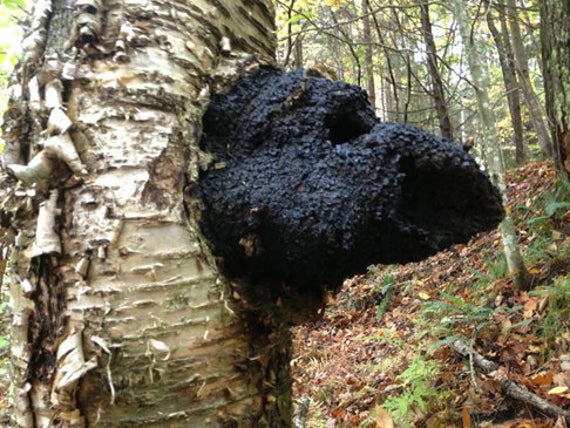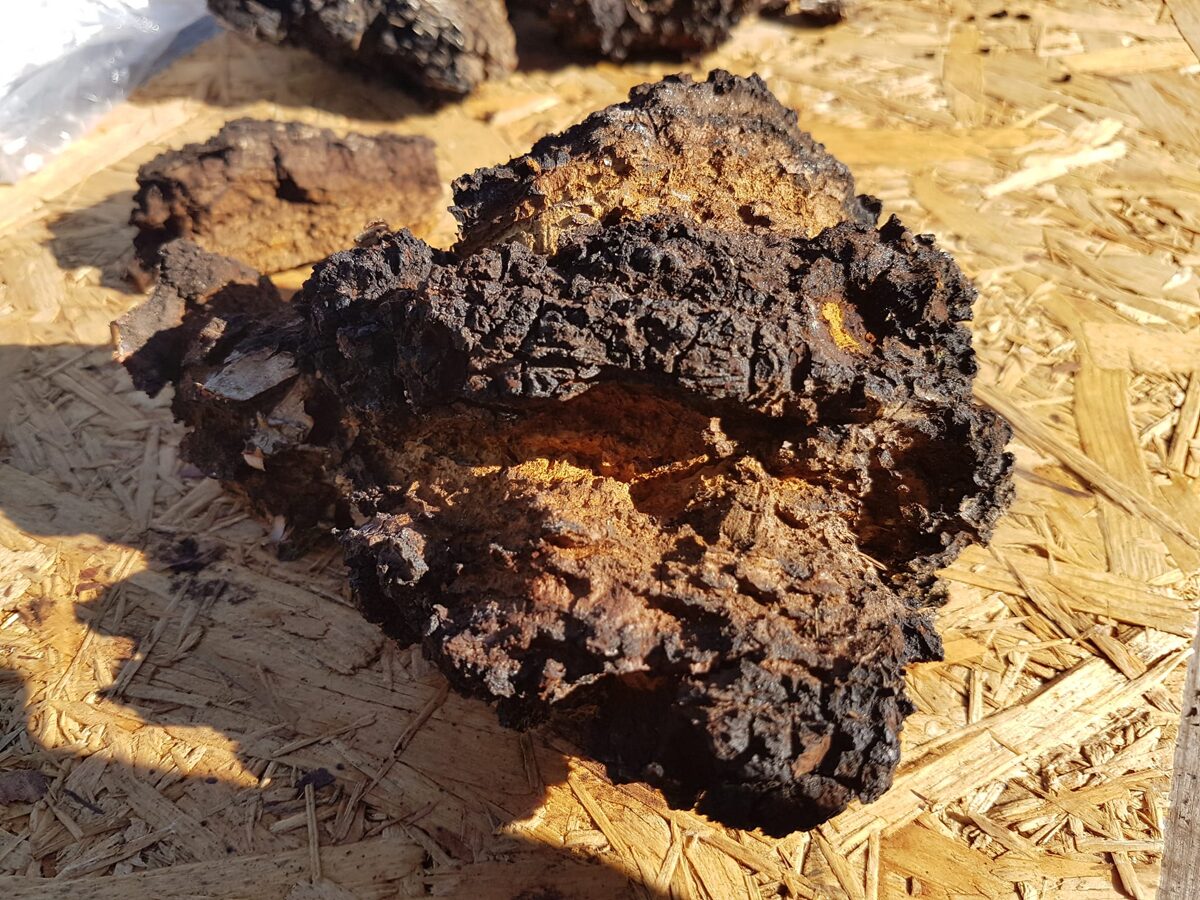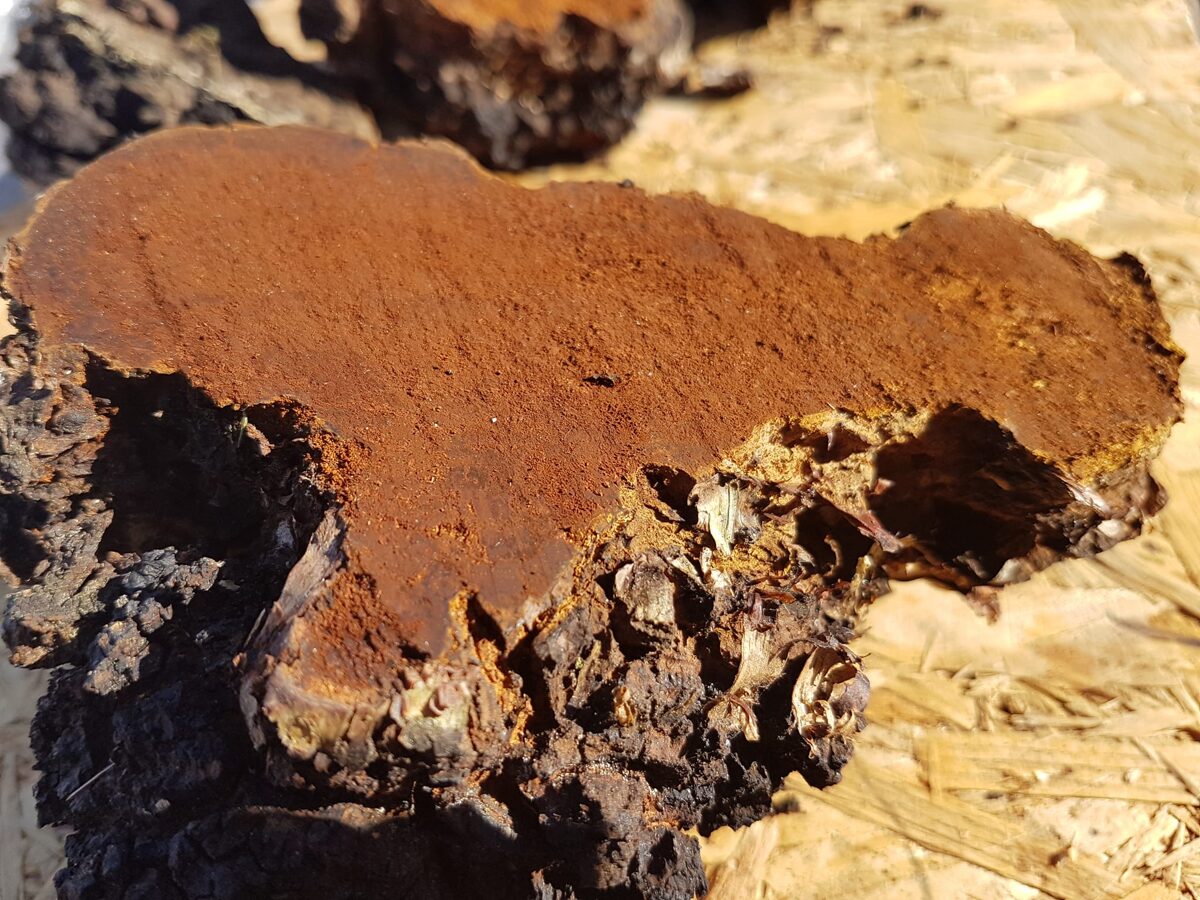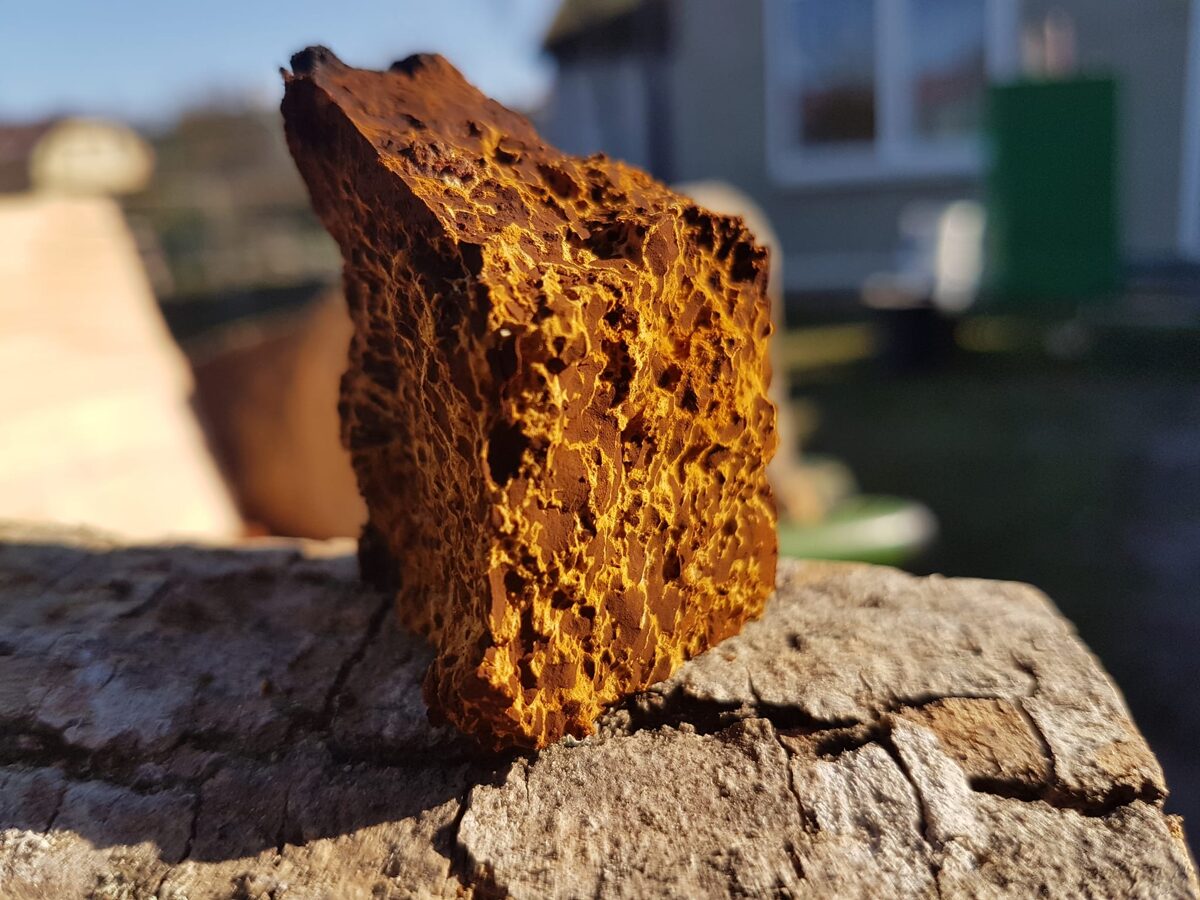 |  |  |  |  |
  |  |
Birch chaga, or clinker polypore is a parasitic fungus that forms hard growths on the tree trunk. It can be found not only on birches, but also on maples, rowan, willows and other deciduous trees. Therefore, it can be fully called birch chaga, because only growths collected from birches are used for medicinal purposes. The growths are the sclerotium of the fungus. Sclerotium is a barren body of the fungus, where valuable substances accumulate. The fungus itself is under the bark of the tree and is annual. As soon as the sclerotia contains enough valuable substances and the host tree dies, the chaga becomes active and within about a year reaches full maturity and is able to produce spores.
That is why chaga is not collected from dead birches, because the fungus extracts all valuable substances from its sclerotia in order to be able to mature on its own.
The chaga reaches its full maturity in an average of 15-30 years, but in rare cases it can live up to 80 years. Accordingly, during this period of time, the host tree is permanently killed and an extensive brown troupe develops.
Interestingly, chaga prevents the formation of other fungi that form brown rot on the wood. If such a neighbor appears, then the chaga does not form much sclerotia and it is basically half-empty, from the point of view of valuable elements, because the bulb actively consumes its reserves to destroy competitors.
When the tree dies, the chaga activates, under the bark it can cover the tree trunk in an area of 3 meters or more. After some time, the bark of the tree opens and the spores begin to spread naturally, and they are also helped by a specific species of beetle. Researches of recent years show that it is insects that ensure greater spread. When the spores reach another tree, at the site of the damage, after 3-4 years, a new, visible sclerotium of the fungus begins to form in that place.
It is worth noting that the sclerotium of the fungus is a sterile part of the fungus, and when you process it, you can not be afraid that you will spread the spores to the birch trees in your yard. It must be understood that the spore of the fungus can travel more than 10,000 km, so it is physically impossible to protect the trees, even if you work with spore-containing mushroom fruiting bodies.
It should be noted that birch chaga is not collected:
- from dead trees - as we found out earlier, sclerotium in this case is just a mushroom mass without valuable components;
- growing below 2m - according to research, the lower the birch chaga is on the trunk, because it is more affected by moisture (which washes out the valuable substances) and they have a significantly lower content of valuable substances;
- in the vicinity of swamps and cities - sclerotium of birch chaga accumulates not only valuable substances, but also harmful ones, including radioactive substances such as cesium and americium. The swamp preserves traces of radioactive accidents in itself for many years.
Birch chaga has all the usable parts. It consists of three layers, the base (loose and porous) contains small amounts of valuable substances, it can also be cut, but not necessarily, the middle brown layer has the highest content of valuable substances and there is also a top layer (black), which is usually recommended to be cut off. But the top layer is exactly the one that contains mushroom chitin, which, in turn, is an effective remedy against various viral diseases. That is why birch chaga also gained its popularity, as it turns out to be effective against various seasonal viral diseases and also new viruses.
Traditionally, mushroom sclerotia are dried up to 60C, but they calmly withstand the temperature regime up to 120C. However, I recommend sticking to tradition and drying it no higher than 60C.
Birch chaga has an average shelf life of 2 years. Provided that it is stored properly - dry, airtight, hidden from the sun.
Birch chaga contains about 20% water-soluble pigments that form a chromogenic complex of polyphenol carbonates, pterins (the basis of pteridines); polysaccharides (6-8%), agaricin and humic chaga acid (up to 60%); organic acids 0.5-1.3%; oxalic acid, acetic acid, formic acid, vanillic acid, ceric acid, n-hydroxybenzoic acid; triterpenic acids from tetracyclic triterpenes; lipids (di- and triglycerides); steroid substances (sterols - ergosterol, and tetracyclic triterpenes - lanasterol and inotodiol); lignin, cellulose, free phenols, flavonoids, gum peucedin, resin, traces of unknown alkaloids; alkalis (12.3%), which are rich in manganese; other trace elements, such as oxides.Medicinal significance
Treatment courses are allowed for 3-5 months, but a break of 7-10 days is required between them, as a minimum.
Chaga decoctions and infusions work especially effectively on seriously ill patients - they remove pain symptoms and improve their condition and well-being.
It is very important to understand that birch chaga is not a medicine against oncology , it has strong antioxidant properties and can strongly help to prevent oncology from occurring at all, as well as to improve the health of cancer patients.
Chaga is used as a symptomatic remedy in case of oncological diseases, it improves the general condition of people with oncological diseases, it is also used for the treatment of diseases of the gastrointestinal tract: chronic gastritis, dyskinesia of the hyperkinetic type, unexacerbated gastric and duodenal ulcers, gastric and intestinal polyps, gastralgia , enteralgia, liver and spleen problems. Chaga preparations are used in insomnia to calm the nervous system, to regulate catalase and protease metabolism, to increase the body's resistance to infectious diseases.
Preparations and birch sap are prescribed for people suffering from eczema, atopic dermatitis, erotroderma. In case of wounds, injuries, burns, frostbite, skin inflammation, pubertal acne, herpes virus (skin and mucous membranes), papilloma virus, warts, leukoplakia, varicose veins.
Preparations containing birch chaga have a wide spectrum of pharmacological activity and are used as an active biogenic stimulator. When these preparations are used orally or in a specific place, they increase the body's resistance to various infections, are excellent in the treatment of inflammation, improve metabolism, activate metabolism in brain tissue, restore the activity of inhibited enzyme systems, increase the functional properties of weakened organs and body parts.
The pterins present in chaga provide a cytostatic effect. They enhance the cytostatic activity of oncology preparations, reduce the growth rate of tumors, promote gradual regression and prevent the formation of metastases. In parallel with the effect, chaga will also improve the overall well-being of the cancer patient, restoring work capacity and increasing tone.
The chromogenic polyphenol carbon complex also reduces oncological activity. Phenolic compounds regulate cytoplasmic and mitochondrial activity. Oncological cells are directly dependent on glycolysis, so affecting the processes of glycolysis will negatively affect the development of cancer cells.
Chaga is also used to treat radiation leukopenia and is infused during radiation therapy to reduce the effects. It will help restore blood composition and improve blood circulation.
Chaga preparations also have antispasmodic, diuretic, antimicrobial, reparative effects. Improves the functioning of the gastrointestinal tract, helps to treat gastric and duodenal ulcers and is highly effective in cases of gastritis. Mushroom decoction reduces arterial and venous blood pressure, reduces pulse rate, regulates the activity of the cardiovascular and respiratory system, stimulates blood production (increases the level of leukocytes).
The decoction of the inner part of the birch chaga will have hypoglycemic properties, but it should be remembered that the outer part of the mushroom does not have such properties. The maximum decrease in the level of glucose in the blood is observed after 1.5-3 hours, after using the decoction. The blood sugar level decreases by 15.8-29.9%.
When used externally, birch chaga has anti-inflammatory, healing and pain-relieving properties. It protects the skin from the effects of the external environment, including viral and fungal infections, removes edema and promotes skin regeneration.
Inotodiol exhibits antiblastic activity. Thanks to the manganese present in the alkali. It probably has medicinal value in chaga, as an enzyme activator.
Observations of the clinical effect of chaga were performed on stage IV cancer patients who cannot undergo radical surgical interventions and radiation therapy, because the cancer has possibly grown into neighboring organs and caused metastases. When using birch chaga, patients improved their general state of health and well-being, increased appetite, stabilized the gastrointestinal tract, decreased fatigue, disappeared problems with skin thermoregulation and sweat secretion, and increased hormonal estrogen activity.
With long-term use of birch chaga, 50% of patients improved peripheral blood parameters (hemoglobin, erythrocytes increased, erythrocyte sinking rate and leukocyte count decreased, in case of leukocytosis). Anti-anemic properties of chaga were observed in patients who failed to change their blood counts with conventional preparations and blood transfusions. The function of the cardiovascular system improved, enzymes were close to normal (catalase and protease), pain symptoms decreased (the need for narcotic drugs decreased, 2-3 times), interest in the surrounding world was restored, working abilities returned. Some of the patients even returned to work. It was observed that the tumor began to grow more slowly and the rate of metastasis development decreased. According to a specific study on patients, those who used chaga lived longer.
Based on these studies, oncologists from the National Research Institute named after NN Blokhin (Moscow) developed medical preparations based on chaga, which are successfully used even today and not only oncologists use them on their patients.
As an aid, chaga is also used by otorhinolaryngologists for the treatment of throat cancer (used in the form of inhalation), because it restores the function of swallowing, reduces hoarseness, improves breathing, and reduces inflammatory processes.
Chaga is well tolerated and non-toxic compared to chemotherapy.
Birch chaga preparations are also significant as active biostimulators, they strengthen the body's protective functions, stimulate the central nervous system and improve metabolism. Birch chaga also stimulates metabolic processes in the brain tissue, which is manifested as the activation of bioelectrical processes in the cerebral cortex. Restores the body's enzyme activity, improves heart function and respiratory processes. A positive effect on the treatment of psoriasis has also been observed.



